| Srl | Item |
| 1 |
ID:
105460
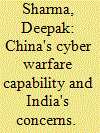

|
|
|
|
|
| Publication |
2011.
|
| Summary/Abstract |
The Chinese cyber warfare department's multiple agencies and individuals are seriously working towards the overall objective of instantly disrupting or at least weakening the adversary's computer networks so as to paralyse his decision making capability at the very commencement of hostilities. It is very difficult to protect networks from such attacks. The weakest link in cyber security measures are the persons operating the system who often, knowingly or unknowingly, default on cyber security measures. It is possible for defence to have an exclusive secure network with air gap from civil and public networks which ensures that the adversary is not allowed to even access its periphery.
|
|
|
|
|
|
|
|
|
|
|
|
|
|
|
|
| 2 |
ID:
105461


|
|
|
|
|
| Publication |
2011.
|
| Summary/Abstract |
Nepal used to be a safe zone for India. China was least interested in Nepal till 1950s. But strategic design changed once China forcefully occupied Tibet. Nehru tried to strengthen the Indian positioning in Himalayan sphere vis-àvis China. Things became more complicated once China started intruding in Nepal. This article tries to see the emerging Chinese threats from Nepal. Since 1,751 km India-Nepal border runs through 20 districts of five Indian states. The India-Nepal border is open. China has tried through its long strategy to erase Nepalese dependency on India. The Maoist forces in Nepal have played
the China card to balance India. Rails and roads infrastructures have created a route through which China can move to Indian heartland. The economic and other Chinese packages are designed to weaken India's strategic gain in Nepal. If Chinese wave continues unabated in Nepal, India might face multiple security threats in future.
|
|
|
|
|
|
|
|
|
|
|
|
|
|
|
|
| 3 |
ID:
105465
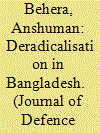

|
|
|
|
|
| Publication |
2011.
|
| Summary/Abstract |
The Sheikh Hasina government has been able to crack down on militant outfits by initiating a process of de-radicalisation ever since it came to power in 2009. This has been evident from the fact that since 2009 the violent activities of the Islamic extremists have been curtailed with relatively little bloodshed. And the same has been the case with the left wing extremists in the country. The Sheikh Hasina regime is more determined, than any government since the formation of Bangladesh to de-radicalise the political as well as the social structure of Bangladesh. This paper will describe and analyse eradicalisation process underway in Bangladesh and the emerging challenges.
|
|
|
|
|
|
|
|
|
|
|
|
|
|
|
|
| 4 |
ID:
105456
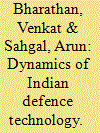

|
|
|
|
|
| Publication |
2011.
|
| Summary/Abstract |
The philosophy of approach toward military technology is based on purpose, vision, relevance, efficiency and performance. Being Indian in content is what needs to be added to the above! Sixty four years down the line, four battle engagements later, our defence technology story is one of unexpected miracles and unacceptable failures. It is in above context that a holistic understanding of the foundation on which the edifice of the defence industrial base of India needs to be progressively pillared becomes imperative?
|
|
|
|
|
|
|
|
|
|
|
|
|
|
|
|
| 5 |
ID:
105459


|
|
|
|
|
| Publication |
2011.
|
| Summary/Abstract |
As of now, institutions within Pakistan are strong enough to prevent both the balkanisation of Pakistan as well as the possibility of the state falling into theocratic hands. Pakistan is also unlikely to wind up terror operations against India as it considers the terrorist organisations to be its strategic assets. Internal disturbances within Pakistan allow it to maintain plausible deniability and the shifting of blame on to non-state actors over whom Pakistan claims it has no control. This paper argues that India's response to terror will have to be well thought out. Waging war against Pakistan to counter its support to terrorist activities within India is not likely to work. It will polarise Pakistani society and push it further into the hands of fundamentalist forces. In any event, the battle to be waged is ideological and peace can never be achieved unless India displays the will to act.
|
|
|
|
|
|
|
|
|
|
|
|
|
|
|
|
| 6 |
ID:
105464
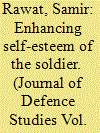

|
|
|
|
|
| Publication |
2011.
|
| Summary/Abstract |
This paper attempts to address the increasing challenges faced by the Army -both individually for the soldier and collectively as an organization. It is an attempt to balance the soldier's individual need for personal growth and development, optimizing his potential, as well as the military's need for mission effectiveness.
|
|
|
|
|
|
|
|
|
|
|
|
|
|
|
|
| 7 |
ID:
105466


|
|
|
|
|
| Publication |
2011.
|
| Summary/Abstract |
The Indian Navy (IN) has one Naval Dockyard (ND) each at Mumbai and Visakhapatnam and one Naval Ship Repair Yard (NSRY) each at Kochi, Port Blair and Karwar. The repair and refit requirements of IN ships and submarines are collectively met by the above mentioned repair agencies. NDs have the capacity and capability to handle Major Refits (MR). The Operational-cum-Refit cycle of each ship / class of ship is promulgated by IHQ MoD (N) from time to time. Refits of IN ships and submarines are undertaken by the naval yards or off loaded to defence/ private shipyards depending on the capacity and / or expertise. Implementation of outcome budget is exempted as per the guidelines of MoF. However, as per the directives of the defence minister and in accordance with the recommendations of Standing Committee on Defence, the outcome budget in respect of NDs has been prepared for the year 2010-11. This paper briefly traces the evolution of the concept of outcome budget in India and thereafter brings out the experiences during the preparation of the
first ever Outcome Budget for Indian naval yards.
|
|
|
|
|
|
|
|
|
|
|
|
|
|
|
|
| 8 |
ID:
105458


|
|
|
|
|
| Publication |
2011.
|
| Summary/Abstract |
The transformation from the comforts of outlay budgeting to an environment of accountability with outcome budgeting is difficult but not impossible. This re-engineering is essential as in the absence of outcome budgeting, budget management may be ineffective and ineffective budget management would weaken the Public Financial Management (PFM) system. A weakened PFM could even threaten established economic, social and political equilibriums. The weaknesses in the existing system need to be accepted and a roadmap for budgeting in terms of outcomes needs to be worked out and followed by programme managers of public authorities.
|
|
|
|
|
|
|
|
|
|
|
|
|
|
|
|
| 9 |
ID:
105462


|
|
|
|
|
| Publication |
2011.
|
| Summary/Abstract |
There is sufficient space for India to wage a limited war against Pakistan. Fears of escalation to the nuclear realm are grossly exaggerated by the critics of limited war, who ignore or misinterpret several factors (such as nuclear deterrence and international pressure) that would prevent conflict expansion in South Asia. While the current level of political-diplomatic-military planning in India lacks the capacity to meet the essential tenets of limited war, this can change and the requisite conditions can be achieved through better synergy and collaboration between different spheres. Second, not only is there potential space, but that by exploiting this space India can extract critical gains vis-à-vis Pakistan, which would compensate for the risk (less than assumed) inherent in that exploitation. Furthermore, a limited war posture can work in tandem with and even bolster India's long-term grand strategy in its relationship with Pakistan.
|
|
|
|
|
|
|
|
|
|
|
|
|
|
|
|
| 10 |
ID:
105463


|
|
|
|
|
| Publication |
2011.
|
| Summary/Abstract |
The present paper analyses and examines the Armed Forces Special Powers Act (AFSPA) in respect of legal aspects. It first discusses it in terms of domestic law, international humanitarian law (IHL) and human rights law. Given India's obligations under international human rights instruments going beyond domestic law is necessary in any such discussion. Ensuring complementarity between the Act in its application in armed conflicts and IHL, would contribute towards making the Act more 'humane'. The second part discusses the Act from security perspectives. In doing so, it reaffirms that respect for human rights and humanitarian law in countering insurgency is of strategic import. In conclusion,it makes some recommendations for the military which will enable it ensure that AFSPA and the IHL complement each other.
|
|
|
|
|
|
|
|
|
|
|
|
|
|
|
|
| 11 |
ID:
105457
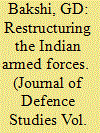

|
|
|
|
|
| Publication |
2011.
|
| Summary/Abstract |
This paper broadly deals with two important aspects. First, it analyses various security challenges that India is facing at present; and second, it examines the need for restructuring the Indian Armed Forces to address these security challenges. It explains that India is in a two front situation with China to the
north and Pakistan to the west. Left Wing Extremism and jihadi terror form a half or a third front. The core of any Indian grand strategy must focus on dealing with these threats sequentially and never simultaneously. India will have to rely upon its own resources to safeguard its vital national interests. In the years ahead it will increasingly be called upon to respond to ever greater challenges from within its geo-political environment. It concludes by stating that great civilisations arise only in response to such challenges.
|
|
|
|
|
|
|
|
|
|
|
|
|
|
|
|